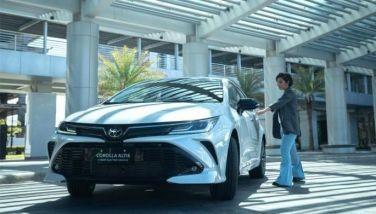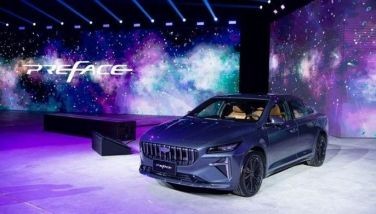Driving the new Kia Sorento
MANILA, Philippines - If you think that the new Kia Sorento looks more European than Asian in design, it’s undoubtedly the influence of Kia’s German design chief Peter Schreyer. His signature? That evocative shield-like front grille that will be appearing in future Kias.
While the new Sorento still retains styling cues from its 1st-gen predecessor, it also has numerous styling cues that can be picked up from, say, a BMW X5 or a Volvo XC60 – namely in the use of convex and concave body panels as well as the flat black color on the window pillars and on the edges of the wheel wells and on the running board. And the Sorento looks all the better – and much more upscale – for it.
Viewed from the front, the P1.79 million Sorento’s chrome-framed black honeycomb grille and the serious-looking quad headlamps are its most compelling design aspects. The blacked out foglamp surrounds also add to the menacing look.
The side is minimally embellished – no pretentious plastic fender flares, just those thin black plastic moldings that define the fender openings and mild sheet metal sculpting on the lower portion of the doors. A chiselled-in character line serves to frame the windows. Another bold design element is the thick D-pillar, which creates an impression (visual and literal) of strength. The new Sorento is also significantly sleeker than the previous model, with an aerodynamic drag coefficient of 0.38 (down from 0.425).
The rear end has the strongest ties to the previous Sorento, but has been modernized with LED tail lamps. A chrome license plate garnish, a spoiler at the top of the tailgate, and large red reflectors (now a common design element among many cars, vans and SUVs) on the black rear bumper brighten up the otherwise simple rear end.
Kia engineers ditched the old body-on-frame structure and designed an all-new monocoque bodyshell, helping the new Sorento lose 215 kg and achieve a more car-like ride. The Sorento rides on fully independent suspensions (multilink at the rear) with coil springs all-around. Tires are 235/65R-17 all-terrain rubber on 17-inch alloy wheels.
My test unit came with a 2.4-liter variable valve timing-equipped 4-cylinder gasoline engine. It generates an impressive 174 ps at 6,000 rpm and 23 kg-m of torque at 3,750 rpm. The motor proved smooth and strong for everyday driving and for the occasional high-speed overtaking bursts. This motor is mated to an equally smooth-shifting yet responsive 6-speed zero-maintenance automatic with manumatic function.
Of course, no non-turbocharged gasoline engine can match a modern common-rail diesel engine in terms of torque and fuel economy, so if you’re used to the power of CRDi motors, you might find the otherwise smoother and quieter gasoline Sorento a bit down on grunt. In any case, the CRDi-powered new Sorento should be available by the time you read this.
I wasn’t able to take this 4x4 model off road (who does?) but it does come with a 4WD Lock mode that distributes power 50:50 between the front and rear axles for use on sand, snow, and on unpaved roads at speeds below 40 kph. A nifty feature is the automatic cancellation of 4WD Lock mode when the vehicle exceeds 40 kph (to prevent driveline damage) and automatic return to 4WD Lock mode when speeds fall below 40 kph. There is also a P1.69 million 4x2 variant for those who don’t plan to venture off road.
Inside, there’s plenty of space for all seven passengers, although the rearmost occupants are better off being vertically challenged as legroom is a bit tight – just like with third-row seats in most 7-seaters. This Kia’s interior design (I love its Nissan Z-car-inspired 3-cylinder instrument panel) as well as its overall fit and finish won’t look out of place in a Volvo SUV.
I particularly liked the 4x4 model’s standard Engine Start/Stop button as well as the Smart Key that lets you lock and unlock the doors even with the key in your pocket or handbag. The new Sorento also boasts Aux, iPod and USB connectivity.
Safety features that my Sorento test unit had include ABS, and RPAS (Rear Parking Assist System) as well as anti-whiplash headrests and dual front airbags. It also uses lots of high-tensile strength steel for low NVH levels and crash protection. The new Sorento meets the highest ratings in NHTSA, IIHS, and EuroNCAP crash tests.
All things considered, the Sorento is – yet again – a perfect example of how the Korean carmakers have caught up with the best from Japan, Europe, and America.
THE GOOD
• Stylish new sheet metal
• Impressively low NVH levels/high build quality
• 6-speed manumatic
• Strong, refined performance
• Spacious and handsome cabin
THE BAD
• Leather seats and more safety features would have been nice
THE VERDICT
• In one model change, Kia vaults to the top of the midsize SUV wishlist.
- Latest





























